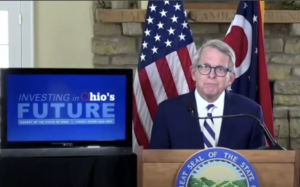News
Ohio Governor Lays Out His Proposed Two-Year Budget
By: Jo Ingles | Statehouse News Bureau
Posted on:
COLUMBUS, Ohio (Statehouse News Bureau) — Ohio Governor Mike DeWine laid out his proposed two-year state budget that sinks $1 billion into one-time spending.

“We will be supporting Ohio’s small businesses, strengthening Ohio’s communities, growing Ohio’s skilled workforce and telling Ohio’s story.”
DeWine said the “Investing in Ohio” initiative includes:
- Investing $200 million in grants for bars and restaurants;
- Investing $150 million in grants for Small Business Relief Grant applicants, who previously applied and are qualified;
- Investing $50 million in grants for lodging industry businesses;
- Investing $40 million in grants for indoor entertainment venues;
- And investing $20 million in grants for new businesses, many of whom were unqualified to receive previous funding.
DeWine also said his budget will “tell Ohio’s story” by investing $50 million in a campaign to bring Ohioans who have moved elsewhere back home and to try and attract new residents to take advantage of career opportunities and college availabilities.
Upon hearing that, the minority leader of the Ohio House, Emilia Sykes tweeted her thoughts on why people don’t want to live in Ohio.
https://twitter.com/EmiliaSykesOH/status/1356313946685382659?ref_src=twsrc%5Etfw%7Ctwcamp%5Etweetembed%7Ctwterm%5E1356313946685382659%7Ctwgr%5E%7Ctwcon%5Es1_&ref_url=https%3A%2F%2Fwww.statenews.org%2Fpost%2Fohio-governor-lays-out-his-proposed-two-year-budget
When asked about the comments from Sykes and others, Governor DeWine responded saying, “Ohio is a welcoming place. I don’t care who you are. We want you to come to Ohio. You know it’s a progressive state.”
DeWine said the state the budget doesn’t raise taxes though it will raise some fees. And it doesn’t touch the nearly $3 billion in the state’s rainy day fund though DeWine hasn’t ruled out using it in the future to address needs brought on by the pandemic.
This story will be updated as new information becomes available.


